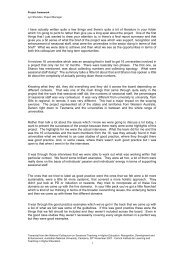A tutor's guide to teaching and learning at UQ - TEDI - University of ...
A tutor's guide to teaching and learning at UQ - TEDI - University of ...
A tutor's guide to teaching and learning at UQ - TEDI - University of ...
You also want an ePaper? Increase the reach of your titles
YUMPU automatically turns print PDFs into web optimized ePapers that Google loves.
Section 3: Effective Small Group Teaching <strong>and</strong> Learning 29Fishbowl – this is a gre<strong>at</strong> method for introducing a bit <strong>of</strong> fun<strong>and</strong> energy <strong>to</strong> a focussed class discussion. Some students star<strong>to</strong>ff the discussion by sitting in a small circle <strong>of</strong> chairs, with therest <strong>of</strong> the class in a surrounding circle <strong>of</strong> chairs, listening <strong>to</strong>the discussion. Students in the outer circle can join in thediscussion by swapping se<strong>at</strong>s with someone in the small innercircle.There are many other small group str<strong>at</strong>egies you can use – see the References<strong>and</strong> Web Resources section in this book.Dealing with difficult situ<strong>at</strong>ionsDon’t panic!! Many tu<strong>to</strong>rs may neverencounter a really difficulty, tricky oruncomfortable situ<strong>at</strong>ion in class. Thosewho do may <strong>at</strong> first feel like just runningaway from it, but like all the skills youneed as a tu<strong>to</strong>r, you will develop skills inmanaging difficult situ<strong>at</strong>ions withexperience. However, while this may bethe result <strong>of</strong> good luck, it’s probably wortherring on the side <strong>of</strong> caution <strong>and</strong> putting inplace good management str<strong>at</strong>egies in order<strong>to</strong> minimise or avoid such situ<strong>at</strong>ions.Here are three important tips for good classroom management:1. Ground rules help the group work better – especially if the ‘rules’ aregener<strong>at</strong>ed by the students themselves (see Section 1 for details).2. Structure is just as important in small groups as it is in lectures – studentswill work better if the purpose <strong>of</strong> the class <strong>and</strong>/or activity is clear <strong>to</strong> them (e.g.,a st<strong>at</strong>ement <strong>of</strong> aims <strong>and</strong> objectives for the session works well). Just remember<strong>to</strong> be explicit about wh<strong>at</strong> you expect from your students, <strong>and</strong> avoid giving thema task <strong>to</strong> complete without a r<strong>at</strong>ionale – this may help reduce some problems inclass like students being distracted, <strong>of</strong>f track, disinterested, or noncommunic<strong>at</strong>ive.3. Pay <strong>at</strong>tention <strong>to</strong> the ‘<strong>to</strong>ne’ <strong>of</strong> the group – interaction in a small group isgre<strong>at</strong>ly influenced by the <strong>to</strong>ne or <strong>at</strong>mosphere, <strong>and</strong> whether students feel able <strong>to</strong>take a risk in front <strong>of</strong> you <strong>and</strong> their peers. You can actively work <strong>to</strong>wardschanging the <strong>to</strong>ne <strong>of</strong> the group through your own actions <strong>and</strong> non-verbals.



